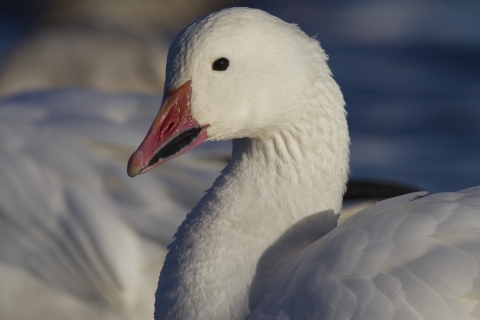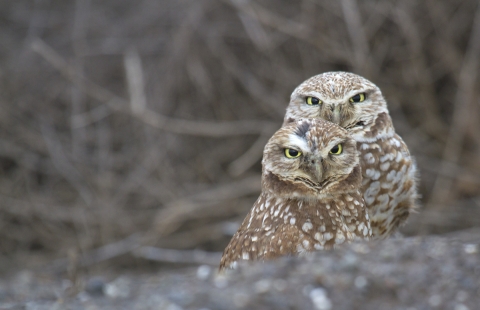Seasons of Wildlife
Nature’s Calendar at San Luis NWR Complex
January
- Numbers peak for geese and ducks
- Wetlands fully flooded
- Bald eagles often observed hunting on refuges
- Winter sees greatest diversity of raptors
February
- Tule elk bulls shed antlers at San Luis NWR
- Great horned owls hatching
- Hawks exhibiting aerial courtship displays
- Large numbers of wintering waterfowl and cranes visible
March
- Waterfowl begin migrating north
- Hawks and herons nesting
- Shorebird numbers building
- Snakes encountered basking in the sun
April
- Wildflowers are abundant around vernal pools
- Tule elk cows begin giving birth to calves at San Luis NWR
- Seasonal wetlands are drained to allow waterbird food plants to grow
- Peak number of shorebirds
- Summer neotroprical songbirds begin arriving
May
- Shorebirds are migrating in breeding plumage
- Songbirds are very vocal defending nesting territories
- Tiger salamanders return to burrows as vernal pools dry
June
- Tule elk antlers fully grown with velvet falling off at San Luis NWR
- Shorebirds migrate north
- Seasonal wetlands are dry
- Songbird and raptor fledglings are visible
July
- Seasonal wetlands are irrigated to encourage waterbird food plants to thrive
- Fall shorebird migration begins
- Coyote pups out exploring their territories
August
- Swainson's hawks have fledged and will form "kettles" over grasslands
- Irrigated pastures attract ibis and long-billed curlews
- Tule elk rut and bugling peaks at San Luis NWR
- Some early northern pintails arrive
September
- Sandhill cranes begin returning mid-month
- Songbirds migrate south
- Monarch butterfly fall migration peaks
- Black-tailed deer rut begins
October
- Aleutian cackling geese arrive at the San Joaquin River NWR
- Greatest bird diversity occurs during fall and spring migrations
- Juvenile snakes emerge
November
- Over 15,000 Sandhill cranes are in the Grasslands by Thanksgiving
- Ross’ and white-fronted geese arrive
- Tiger salamanders begin trek to vernal pools to breed
- Large numbers of ducks present
December
- Snow geese begin to arrive at Merced NWR
- Swans may arrive in small numbers
- Watch for eagles, falcons, and ferruginous hawks
Featured Species
Learn more about several key species at the refuge.
Sandhill Crane
Sandhill cranes are one of the most charismatic winter visitors on the refuge! There are six subspecies of sandhill cranes in North America, but only two are found in California: the lesser sandhill crane and the greater sandhill crane. As their names imply, they are different sizes (greaters are larger). Most of the cranes seen on the refuge are lesser sandhill cranes – they can be seen here from mid-September to early March. The majority of lesser sandhill cranes that winter here nest over 2,200 miles away near Alaska’s Bristol Bay. Cranes require two important habitat components at their wintering grounds. They must have wetlands for roosting in water at night—predators cannot sneak up on them without splashing through the water and making noise–and foraging habitat where they feed during the day. These two areas must be relatively close together since cranes will not “commute” more than a few miles from their roosting grounds to their feeding grounds. Having to travel great distances requires too much energy. At sunrise, the cranes can usually be observed flying off the refuge in mass on their way to nearby foraging grounds. At sunset, they can be seen flying back into refuge roosting areas, creating a predictable daily spectacle to the enjoyment of many visitors.
Snow Goose
Snow geese are a large white goose that makes the refuge its winter home. The arrival of geese each autumn marks the changing of the season. Snow geese usually begin arriving by late October into November. Snow geese are white with black wing-tips. They weigh 5 to 7 pounds and are approximately 28 inches long with a wingspan of 4.5 feet. Snow Geese have a pink bill with a dark line where the top and bottom meet called a “grin patch” which makes them look like they are wearing black lipstick. These geese mate for life and breed in large colonies on the Canadian and northern Alaskan tundra. Snow geese are vegetarians eating grasses, sedges, rushes, forbs, shrubs, and willows. They will eat almost any part of a plant including seeds, stems, fruits, leaves, roots, and tubers.
Coast Horned Lizard
The sand dune system at the Arena Plains Unit of the refuge provides the only horned lizard habitat on the San Luis NWR Complex. These lizards are in decline due to human development and the introduction of invasive ant species, which displace native harvester ants that the lizards eat. Setting aside habitat and dealing with native ants is critical to the survival of this fascinating species. Horned lizards can shoot blood from their eye sockets when they are threatened by a predator. This action often startles the predator and causes it to flee.
Burrowing Owl
Burrowing owls live underground in burrows that have been dug by small mammals such as ground squirrels. They are often observed using the uplands on the refuge. Look for them sitting on small dirt mounds outside their burrows or on fence posts. They hunt flying insects and small mammals on the refuge.




